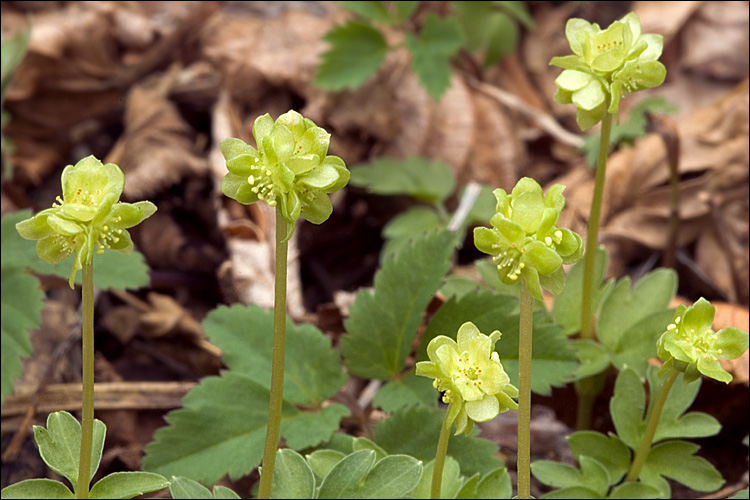
 |  |  |  |  |
 |
Adoxa moschatellina is a perennial herbaceous plant, 5–15 cm tall. It has a short, light-colored rhizome, often with stolons—underground lateral shoots bearing underdeveloped leaves. The flowering stem is usually solitary, but sometimes there are several. Shoots are erect and unbranched. The basal leaves (1–3 in number) are twice or thrice compound with petioles. The stem leaves (usually 2) are trifoliate, opposite, and petiolate. The underside of the leaves is slightly glossy, while the upper side is matte.
Small bisexual flowers are clustered at the top of the stem into a head-like inflorescence, usually consisting of five flowers. The central flower is actinomorphic (radially symmetrical), four-lobed, with four stamens and two calyx lobes. The lateral flowers are weakly zygomorphic (bilaterally symmetrical), five-lobed, with five stamens and three calyx lobes. The corolla is light green in color. The flowers produce nectar and emit a musky scent.
The fruit of Adoxa moschatellina is a greenish drupe containing 1 to 5 seeds, which are dispersed by fish and birds. The plant blooms in May and June. Pollination is primarily insect-mediated, with occasional self-pollination. Propagation occurs more frequently vegetatively than by seeds.
Harvesting of Raw Materials
For medicinal purposes, only the roots of Adoxa moschatellina are harvested. They are collected in mid-September, carefully washed under running water or soaked for half an hour, and then dried in a well-ventilated, shaded place. Decoctions and infusions are prepared from the dried roots, and essential oil is obtained through steam distillation. The shelf life of the raw material is one year.
Chemical Composition
The root of Adoxa moschatellina contains up to 3% essential oil, beneficial organic acids, and tannins. In addition, the plant comprises caffeic acid, p-coumaric acid, δ-lactone, and an iridoid glycoside.
Pharmacological Properties
The pharmacological properties of Adoxa moschatellina have been scarcely studied.
Traditional Medicine Uses
In traditional medicine, the essential oil, infusion, and decoction of the roots of Adoxa moschatellina are used. Although the essential oil is not produced on an industrial scale, it can be obtained at home through steam distillation. The essential oil of Adoxa moschatellina is believed to have antispasmodic, antiseptic, and wound-healing properties. It is applied in the form of baths and compresses for treating affected skin areas. Before use, it is essential to dilute 1–2 drops of the essential oil in a teaspoon of a carrier oil, as a highly concentrated substance may cause irritation or even necrosis.
The infusion of Adoxa moschatellina root possesses antimicrobial properties. It is used externally as compresses for treating purulent wounds and boils, while internally it is taken to help with measles and smallpox.
The decoction of Adoxa moschatellina root is attributed with calming and general strengthening effects. It is applied for excessive irritability and restless sleep.